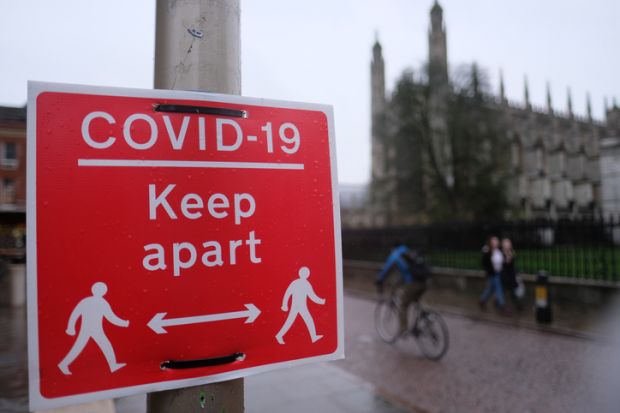The merits of online teaching and learning may divide opinion but the bigger driver of stress and anxiety among both academics and students is the uncertainty about how long it will endure.
Current UK guidance suggests that, with the exception of certain “key-worker pipeline” courses, all teaching should be delivered online until at least mid-February. But given that the Covid situation is at least as critical as it was during the pandemic’s first wave – when campuses remained fully closed – it is hard to predict with any confidence whether it will be safe to have students return to campuses any time soon.
Evidence about the role of universities in transmission appears mixed. A recent genomic study from the University of Cambridge found that student-to-community transmission was low, while epidemiological evidence from the US found that in-person teaching was associated with higher Covid-19 rates in surrounding communities. But inconclusive evidence does not warrant a significant relaxation of measures; a precautionary approach is preferable.
Staggered or phased returns to campuses may help avoid the spike in cases that we saw in September and October, as students arrived on campuses from around the country and the world. However, the advent of the new variant suggests that even if – and it is a big if – we were able to get case rates, hospitalisations and the R (transmission) rate as low as needed by mid-February, campuses would likely see a spate of outbreaks over the subsequent weeks and perhaps months – particularly as a significant proportion of UK students live in halls and other multi-occupancy buildings, which present a higher risk of transmission. The result would be students’ facing periods of self-isolation, being unfairly accused of excessive rule-breaking or even being fenced in.
Mass testing is not a magic bullet. On the one hand, if it proves unsatisfactory (for example, if lateral flow device testing produces too many false negatives, as was found in university settings pre-Christmas), then reopening in February will contribute to increased transmission on and beyond campuses. If, on the other hand, testing and tracing catches a high proportion of Covid-19 cases, then those students affected will face periods of self-isolation on campus. The negative impacts of social isolation during the pandemic are well documented, including in our own research and a large longitudinal study which found that the effects are particularly significant for the 18 to 29 age group, which includes the vast majority of students.
Since uncertainty and instability are major sources of stress and anxiety, and since we cannot commit to a mid-February return, we should make the decision now to keep campuses closed until the end of this academic year. Even if there were a further extension of campus closures, perhaps into March, it would be logistically challenging for many courses and universities to squeeze face-to-face teaching into socially distanced classrooms. We can, however, be confident that vaccine coverage will be more than sufficient to enable in-person teaching to recommence in September.
Of course, such a prolonged commitment to online learning would also necessitate a commitment to compensate students for their loss of in-person teaching and for their inability to use term-time accommodation, where relevant. Partial reimbursements could be considered financial incentives to stay at home, in keeping with the government’s broader public health mantra. But it should be government, not universities, that bears the brunt of this cost; most university staff, after all, are working harder than ever to deliver digital teaching.
Finally, in keeping with the need to “recapture the spirit of March” – the sense that we are all in this together – there is a need for as little exceptionalism as possible. Recent mobility data suggests that working from home, as measured by travel to workplaces, is not as high as it was during the first wave. Given the enormous sacrifice and subsequent job losses across so many sectors, committing to online-only teaching until the autumn would send a message of solidarity with society generally.
Steps universities should take to support staff with digital teaching
Is face-to-face teaching essential for the long term? I think the pandemic has taught us that it is. But is it essential in the short term? I am yet to see persuasive evidence that the pedagogical benefits of restarting it would outweigh the harm caused by the risk of additional transmission inside and, particularly, outside lecture theatres.
It is incumbent on university planners to be realistic, patient and considerate – of students, staff and wider society. They should commit now to keeping campuses closed until the virus is likely to have been brought firmly under control.
Simon Williams is senior lecturer in people and organisations at Swansea University.
Register to continue
Why register?
- Registration is free and only takes a moment
- Once registered, you can read 3 articles a month
- Sign up for our newsletter
Subscribe
Or subscribe for unlimited access to:
- Unlimited access to news, views, insights & reviews
- Digital editions
- Digital access to THE’s university and college rankings analysis
Already registered or a current subscriber? Login








